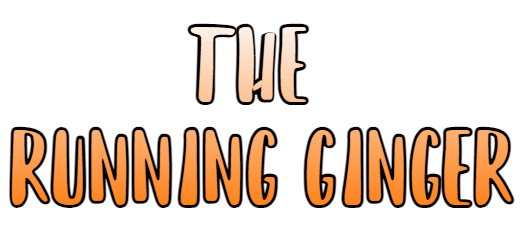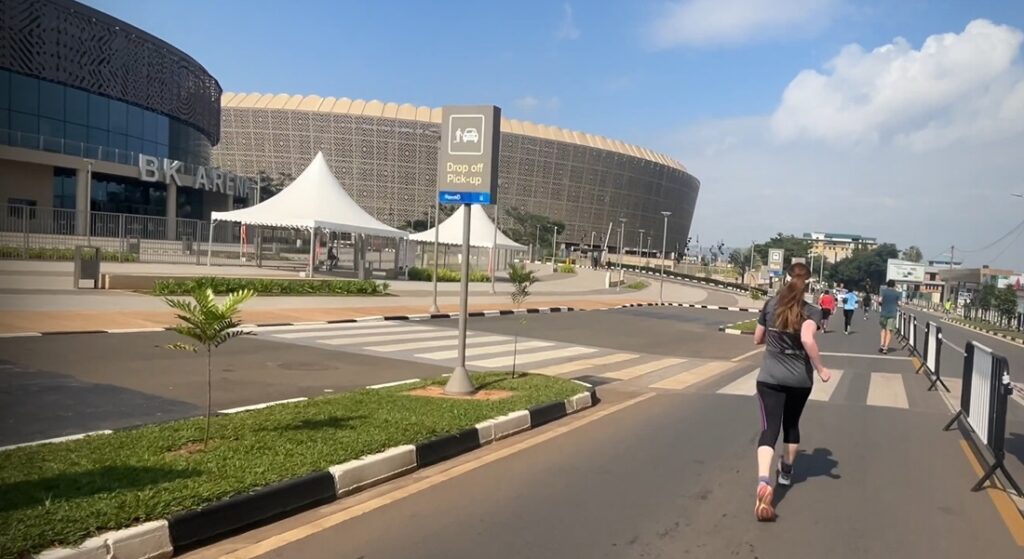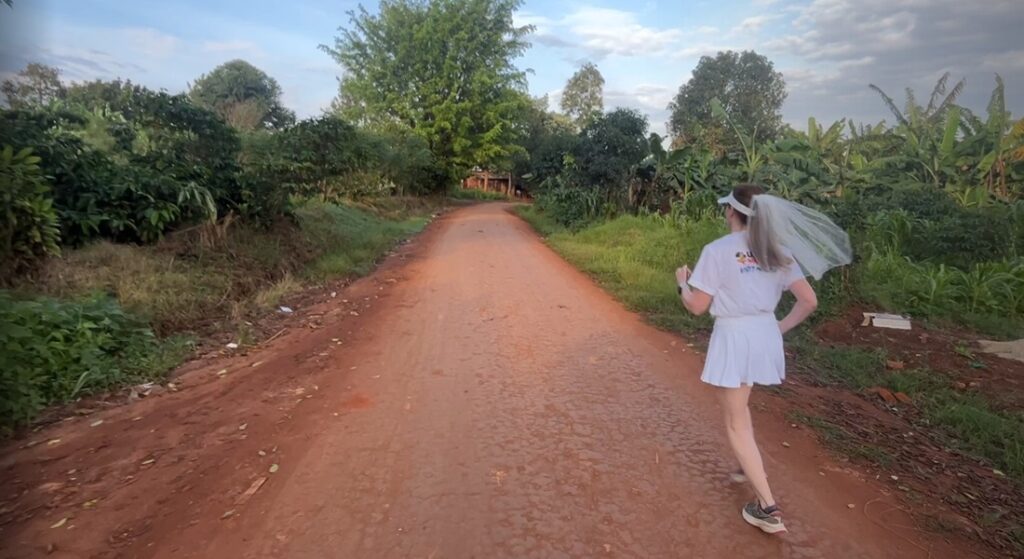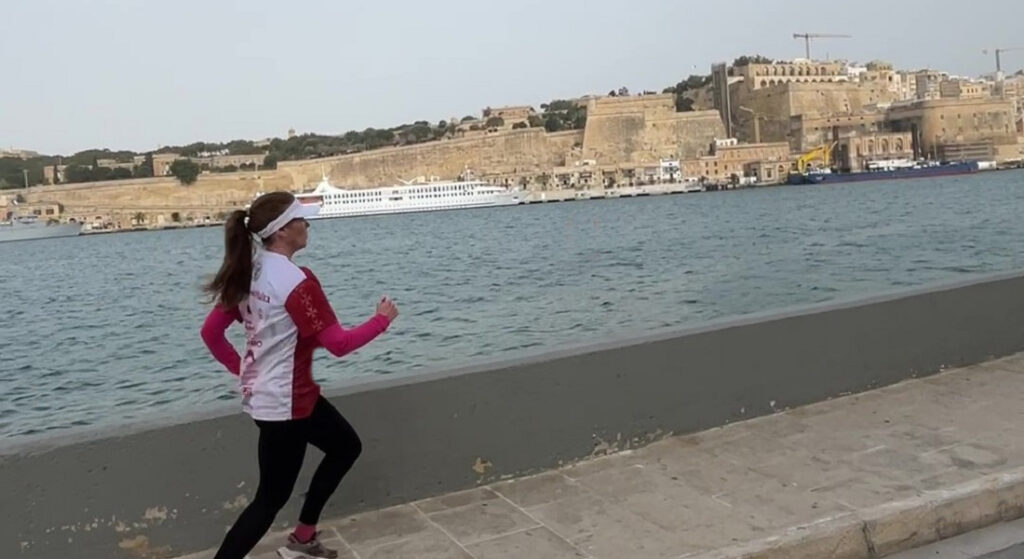Chisinau Half Marathon, September 2023.
We ran the Chisinau Half Marathon in Moldova, one of the most vibrant running events in Eastern Europe 🇲🇩🏃♂️.
Held every September in the heart of the capital, this event offers multiple distances including the marathon, half marathon, 10K, and 5K. The route takes runners through Chisinau’s wide central boulevards, past parks and government buildings, creating a festive and energetic atmosphere throughout the day.
Chisinau might not be on every runner’s radar, but it’s a surprisingly fun and friendly city to explore.
With its mix of Soviet-era architecture, leafy streets, and welcoming locals, it makes a great weekend destination. If you’re considering the Chisinau Marathon or Half Marathon, it’s a well-organized event perfect for combining sport, sightseeing, and discovering Moldova’s capital. 🏅🛫🇲🇩
TLDR; “Too long, didn’t read”
- I just want to run! Take me to RACE.
- I have 1 minute. Take me to USEFUL INFORMATION and FAQ.
- Running is my excuse for travelling. Take me to TRIP.
- Running is my excuse for eating. Take me to CARBOLOADING.
- I want to go back to Soviet times. Take me to TRANSNITRIA.
- I want to know what to read in the plane. Take me to ONE BOOK.
🌍 The trip 📷: What to see in Chisinau if you are running the Marathon
In Chisinau’s National Museum of Art there is a replica of the famous Roman Capitoline Wolf. With the following latin legend:
De la Roma venim, din Dacia traiana…
And, to “Romae cucurri”, to run the “Chisinau Big Hearts Marathon”, which takes place the last weeks of September, we also came from an old Roman province. We arrived to the ancient Dacia from the ancient Barcino 😁
It was a Thursday, almost at midnight. At the airport we started hearing people speaking not in latin, but in Russian. Although Moldova’s official language is Rumanian, Russian is widely spoken. A fact that reinforced our impression that, in these turbulent times, Moldova is very much under Russia’s influence. Not as much as Transnistria, though, a “country that does not exist” which we visited on Saturday. I have written about our trip to Transnistria later at length.
As a curiosity, we were the only Spanish nationals in the Flyone plane flying from Barcelona to Chisinau. Everybody else was Moldovan.
We spent Friday doing some very relaxed sightseeing in Chisinau. It was a warm day. More than 25C degrees, in fact it was sunnier than our Barcelona. And the city appeared peaceful, elegant and safe.

We set off to see the Nativity Catedral, which was destroyed by bombings during WWII, and by local communists later. The neoclassical church stands in the middle of a very classy park. We strolled along this Nativity Cathedral park, which was full of Moldovans relaxing. Young and old, some singing, some chatting, and others eating. Flowers were blooming, old ladies were selling them on the streets, and the whole city exuded a very peaceful feeling. In general, we found the architecture of Chisinau to be very similar to other Eastern European cities. Soviet monuments, generally quite well preserved, Orthodox Churches and very modern shops and businesses. And Moldovan flags, of course. That is a trait that seems to define most of the Eastern European cities we have visited.
We also walked around Stephen the Great’s park, the oldest park in Moldova. Apparently this King, who appears in the Moldavian lei bank notes, had an impressive track record. He won 34 out of 36 battles. In the park we saw the famous Alexander Puskhin’s statue, and later we visited other famous landmarks, like the National Museums of Art and History.
And I especially liked the “Statue of lovers”, a work by Pavel Obreja, in the pedestrian street Eugen Doga.
📅 The Chisinau Marathon Expo 🎽
The “Chisnau Big Hearts Marathon” is a big event. It is not only a Marathon, but a 5k, 10k and 21k race, and it has a “Kids run” on Saturday as well. 17,000 people run it.
The Marathon Expo was located in the city center. Between the impressive Government House of Moldova and the historical Arcul de Triomf, the Triumphal Arch.

We arrived to the Expo at midday and had to queue for a while under a very big Moldovan flag which presides over the Government House. There were very few people, but the process was long. First we had to fill in a declaration of identity (in Russian or Rumanian. Luckily for us, Romanian is Latin 😅 and we could more or less understand it. Then we were given our BIBs (with 4 safety pins included, that was nice) and finally the runners bag. The shirts were bright red and comfortable. The pack had energy drinks, nuts (apparently nuts are a big thing here) and even a whistle. For those cheering, we guessed…

Oh, and also a voucher for a free Pasta Party 🍝 on Saturday! Although we could not enjoy it as we arrived too late from Transnistria: the pasta was served from 15h to 17h.
The Pridnestrovian Moldavian Republic / Transnistria
We decided to visit a “country that does not exist”, Transnistria, officially the Pridnestrovian Moldavian Republic. This is a breakaway state very close to Ukraine. It is located in a narrow strip of land between the Dniester river and the Moldovan-Ukranian border. In fact, we even received an SMS from our mobile company that greeted us: “Welcome to Ukraine!” 😱
We bought a day tour from Chisinau that turned out to be a great success. Lilia, our guide, born and raised in Transnistria, drove us and explained to us a lot of facts about the area. For instance, that only 3 other unrecognized states recognise Transnistria and have consulates in there: Abkhazia, Artsakh and South Ossetia. In fact Russia also has a consulate in Tiraspol, the capital city, but does not officially recognise the country.
After a one hour drive, with another tourist from Germany who came to run too, we got to the “border”, where they check your passports but do not stamp them. In all borders there are Russian soldiers (with the Russian Federation flag 🇷🇺 in their arms), the guide told us that they were “unofficially stationed “ soldiers of the 14th Army, and tanks. Working tanks with the Russian flag on them.
Lilia explained that the 14th Army has been headquartered here from the 1990-1992 war. In fact, in one of the most famous places in Tiraspol, in front of the Suvorov Monument, there was a huge “33” sign marking 33 years of… ¿independence?, counted from 1990.
She also explained about the “importance” of the Sheriff company in front of one of its supermarkets, while we visited the “door to Transnistria” monument in Bender, right after the border.

The tour showed us very interesting landmarks in Bender and Tiraspol, the capital city, and even included a “Soviet lunch”. In Bender we visited the Tighina Fortress, with its museum of Medieval Tortures, and the ghost of the “White lady”. It was a sunny, spectacular day and there were virtually no tourists.
We even saw an Orthodox baptism in the Alexander Nevsky Church, with the priest chanting in a church highly decorated with gold tones.
We bought some souvenirs; with the caveat that here, the Moldovan Leu is not valid… Transnistria has its own currency: the Transnistrian Ruble. Their plastic coins (super colorful) have become collector’s items, but we could only get a 1 ruble banknote.
In Tiraspol, we were indeed transported to the USSR times: our German colleague, who was brought up in East Germany, commented that for him it was a real “travel back in time” trip! For us, coming from West Europe, it was an experience of its own. We saw the House of Soviets, with a very angry Lenin statue in front of it and Transnitrian flags in its facade, and the Government Building with the largest statue of Lenin in front. It is more than 12 meters high.

In front of the Government Building, there is the famous “Victory Tank”, a “thirty four”, a T-34-85 tank that is paraded in the famous “Victory Parade” that takes place in Tiraspol’s main square every 9th of May. In the park there is a memorial dedicated to those who fell in the 1990-1992 war, as well as WWII, Afghanistan and the Chernobyl disaster. Related to this, our guide explained that when she was little, 2 or 3 years after the disaster, she used to go to the local market with her grandmother and see very, very big strawberries, potatoes or cabbages. She was instructed by her Grandma not to touch them: “They are Chernobyl potatoes!”. Too big.

We also saw the impressive Suvorov Monument, in front of the Green Market Center. It is across the Ekaterina the Great Park, a very quiet and beautiful park along the river. As a curious note, the status of Suvorov and Ekaterina are placed looking at each other 😉
And, everywhere, flowers! Next to all buildings, monuments and streets. I specially noticed the roses, of all colors: pink, red, yellow, white…

🍜 Carboloading 🍝: what to eat in Moldova if you are running the Marathon
We were already familiar with the most famous Moldovan dishes, since we had visited Romania in the past, and the cuisine is similar. And we were lucky enough to have restaurants serving traditional food very close to the apartment where we were staying.
Both for carboloading and recovery, as they are rich in carbohydrates and protein, you can enjoy Mămăligă cu Brânză și Smântână (Polenta with Brined Cheese and Sour Cream), Sarmale (cabbage rolls filled with meat), Plăcinte (a type of Pie), or Chiftele cu Piure (Meatballs with mashed potatoes).
But it is not only Mămăligă and Sarmale here! Chisinau center has a very diverse offer when it comes to food: from very good Sushi 🍣 and Pizza 🍕places that open 24 hours, to even American Burgers 🍔 (we ate in the “New York” restaurant of the Radisson hotel and enjoyed it). There are also fancy restaurants that serve Moldovan cuisine with an edge.
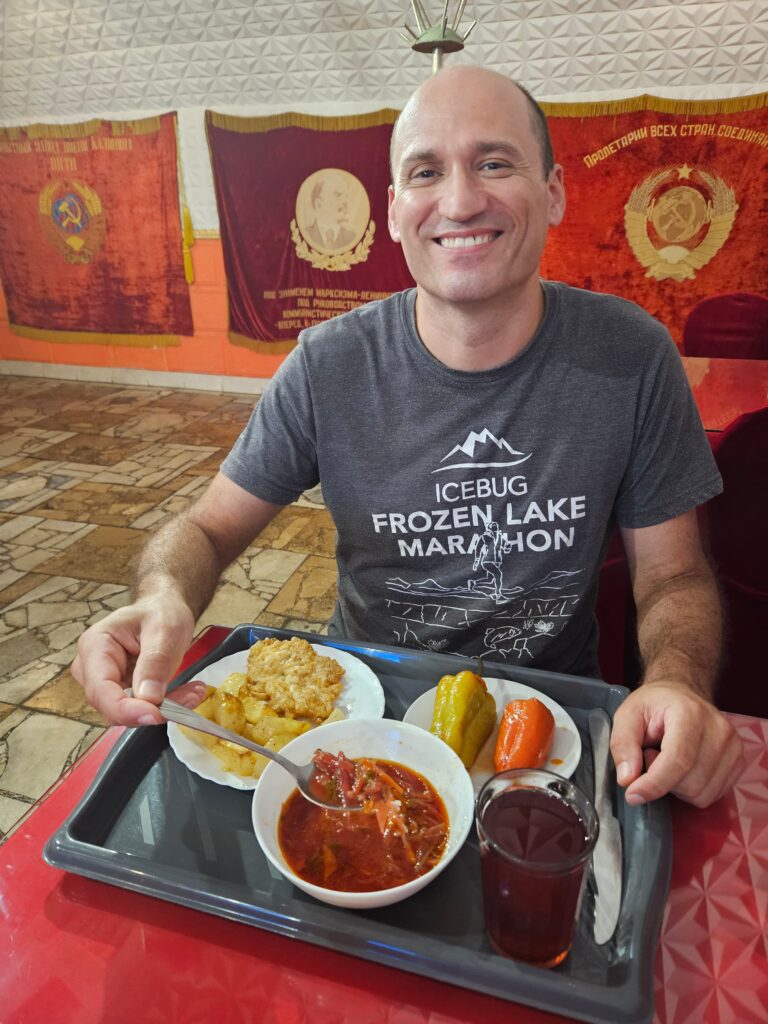
In Transnistria, we ate a “Soviet” lunch. The restaurant sported a lot of Soviet memorabilia, and the food was traditional and with local ingredients. We ate the healthy Buckwheat (Гречка in Russian), which is perfect for carboloading, and also some Borsch.
🏃♀️ The Race 🏃♂️
We stayed just a short walk from the Chisinau Marathon start and finish line, which made race morning smooth and stress-free. 🏃♂️📍
We left around 8:30am after checking the detailed race leaflet included in the runner’s bag. It had everything—from how to properly attach your bib (spoiler: not on your leg! 😅) to a clear course map, expo layout, and lane instructions. 🗺️

This was especially helpful because as the shorter races finished, Stefan cel Mare Avenue was split into three lanes: one for those finishing their lap, one to continue to the next, and one to cross the final finish line. Despite this complexity, everything was clearly marked and well organized.
☀️ It was a stunning, sunny morning in Chisinau—but warmer than expected! Temperatures climbed close to 30°C by midday, which is unusually hot for this time of year. Most past editions had cooler conditions around 18°C, according to the official marathon site.
Still, the 9:00am start felt perfect. We walked through the lively Nativity Cathedral Park, filled with runners of all ages snapping selfies 📸, to reach the iconic starting point between Government House and the Triumphal Arch.
And yes, finishing your race beside a triumphal arch definitely adds a nice touch—even if it’s too small to run under. 😄
The Moldovan flag 🇲🇩 waved proudly above the square, giving the event a local flair. Instead of patriotic anthems, the vibe was casual and community-focused. Many runners wore shirts with charity logos or fun slogans—one read “May the pace be with you” 💫.
We even spotted someone in a Panama hat (clever move for the heat!). Around us, we heard a mix of Romanian and Russian, with most cheers coming in Russian: “давай, давай!” (Come on!)—and grateful runners often replied with “Спасибо!” (Thank you). 🗣️🇷🇺🇷🇴
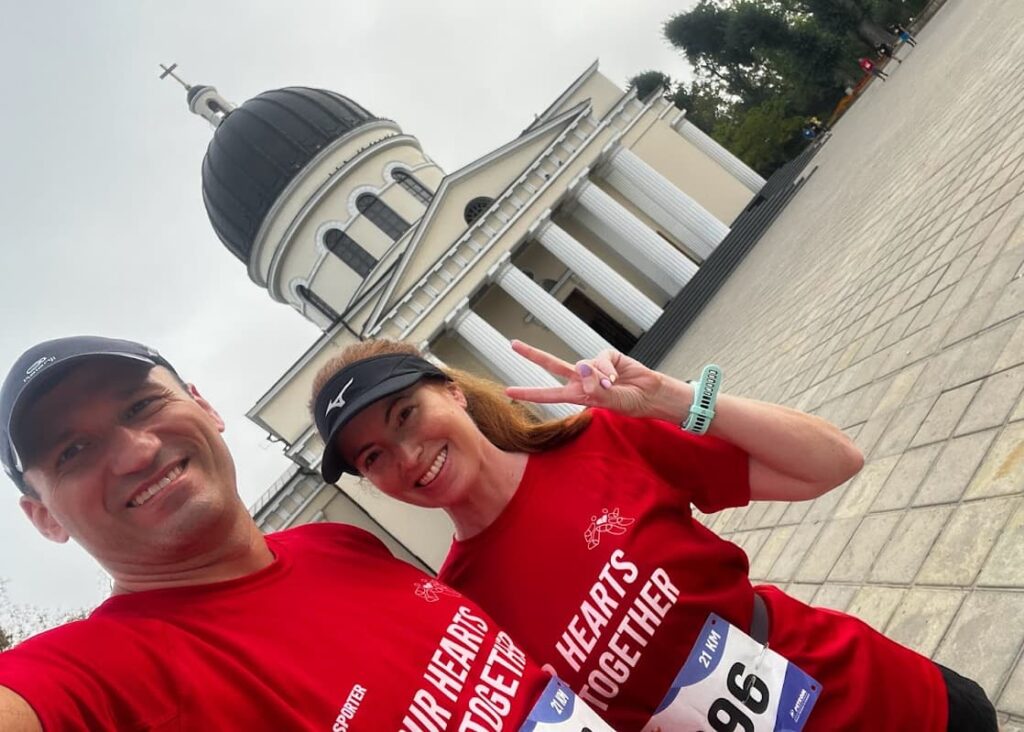
Flags from different countries decorated the wide avenue. We spotted the American 🇺🇸, UK 🇬🇧, and even the French 🇫🇷 flags—but sadly, no Spanish 🇪🇸 flag this time 🙁.
All the races, from the 5K to the full marathon, started together at 9am. Runners were grouped into different pace zones, like the 5:41 min/km slot, which corresponds to 4 hours for the marathon and 2 hours for the half marathon, and so on.
At 9am sharp, we took off! The wide Stefan cel Mare Avenue made the start comfortable and not too crowded, perfect for settling into a good rhythm.
The race was very well organized. Along the course, music stands 🎶 pumped up the energy with DJs playing 90s hits like “Everybody dance now!.
Groups of teenagers dressed in white with bright yellow sunglasses danced hip hop, and I cheered on a fiery redhead dancer who reminded me of myself! Traditional folk dancers in colorful costumes appeared at different points, adding a special cultural touch.
One unforgettable moment was seeing a lone drummer 🥁 playing in front of a stunning Orthodox Church, framed by large Soviet-style buildings in the background — a striking mix of old and new.
Aid stations came every 2.5 kilometers, offering water, Red Bull, and fresh fruit to keep runners fueled and hydrated.
The entire course was on wide, smooth avenues. Besides Stefan cel Mare, we also ran along Dacia Boulevard, which had a gentle uphill stretch of about 25 meters elevation for a couple of kilometers, followed by a nice downhill to recover.
Pace setters were easy to spot, leading groups targeting times like 3 hours, 3:30, 3:45, and 4 hours for the marathon.
Heads up—the cut-off times were pretty strict ⌛: 3 hours for the half marathon and 6 hours for the full marathon.

At kilometer 5, an Orthodox Church was playing holy music ⛪. It was a strange feeling to hear the music coming from an elegant building, their gold roofs shining in the sun, and then, a kilometer later, see a black car that looked like a tank, decorated with the Red Bull logo, which was playing David Ghetta: “Work hard, play hard”. While young blond ladies were offering red bull glasses.
The half marathon course consists of two laps, and the full, of four, which can make you mentally tired. Especially as you pass by the finish line and have to run 1.5 kilometers and then 1.5 back along Stefan cel Mare Avenue.
I found it especially hard to take the “next lap” at kilometer 10.5 when, next to me, people were happily finishing. Moreover as it was starting to get hot.
But then, finishing after the second lap in the middle of a great atmosphere, music and a lot of spectators cheering on you, was great!!!
Although it was worrying to see a runner who had just collapsed 300 meters before the finish line. Some people from the organization were attending him, and the ambulance was coming as I was passing by. My guess was that the heat had a part in it.
All in all, a very well organized marathon, ran in a splendid day along elegant and wide avenues, Orthodox Churches and magnificent buildings: very much recommended.

Useful information
🏆 Chisinau Big Hearts Marathon: 5K / 10k / 21K / 42K. Number of runners: 17,000 (including all distances)
⛰️ Difficulty: Easy. Mostly flat, only an elevation of 30 m in Dacia Avenue. The temperature, though, was too high (but it depends on the year).
🌐 Website https://marathon.md/
🗓️ Third week of September in Chisinau, Moldova, Europe.
👟 City shoes. All asphalt.
✅ Well organized. Not too crowded, frequent water stations and good course: super wide and fast enough (although not suited for a PB)
✅ Super nice atmosphere, with a lot of music (bands, DJs, soloists…)
🏅 The organisation gives you a nice medal, the same one for all races, with the ribbon being the only difference, depending on the different distances. The runners bag is complete, the tshirt is good, and you get a voucher for a free pasta dinner the day before.
❌ 10.5k laps for the long distances and passing by the finish line, which can be mentally tiring.
🏃♀️ FAQ: Chisinau Marathon & Half Marathon 🇲🇩
➡️ When is the Chisinau Marathon 2025?
The Chisinau Marathon is usually held in late September. For 2025, it’s expected to take place around Sunday, 28 September, but check the official site for confirmation.
➡️ What distances are offered?
You can choose from the Marathon (42K), Half Marathon (21K), 10K, and 5K. There’s also a 1.5K fun run for families and kids.
➡️ Where does the race start and finish?
The race starts and finishes in Great National Assembly Square, right in central Chisinau. It’s easy to access by foot from most city hotels.
➡️ How do I register for the race?
Registration is done online through the official site: marathon.md. Prices vary by distance and increase closer to race day.
➡️ Is the course flat and fast?
Yes, the course is mostly flat and paved, looping through Chisinau’s main avenues and city center. It’s suitable for all levels, from first-timers to PB hunters.
➡️ What’s the weather like in Chisinau in September?
Expect mild weather, usually between 12–22°C (54–72°F). It can be sunny or overcast, so bring light layers just in case.
➡️ Are there medals, pacers, and refreshments?
Yes. Finishers receive a medal, and there are pacers for popular target times, as well as aid stations every few kilometers.

Map
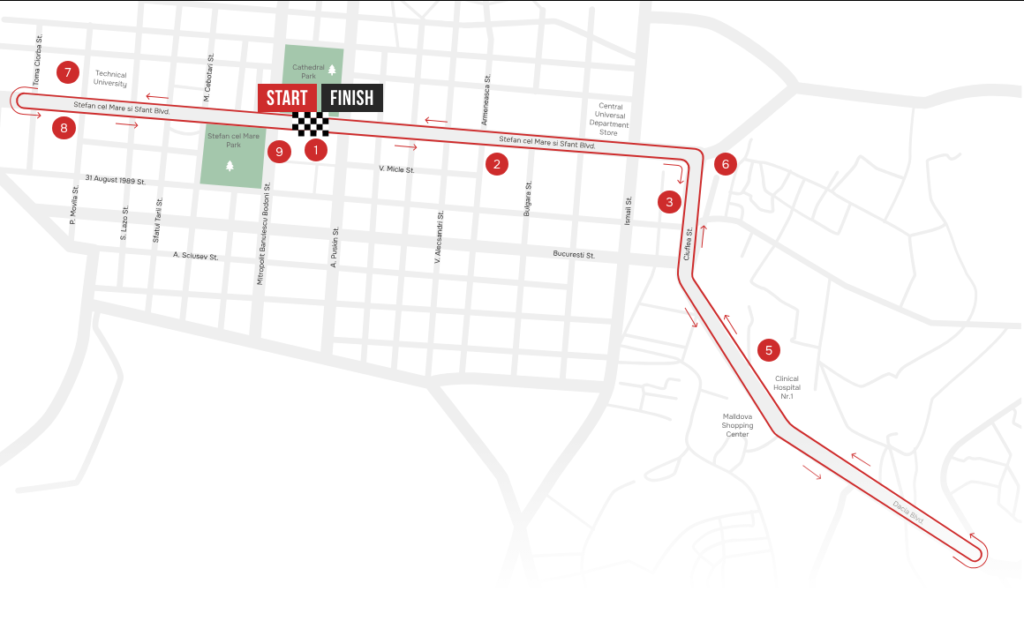
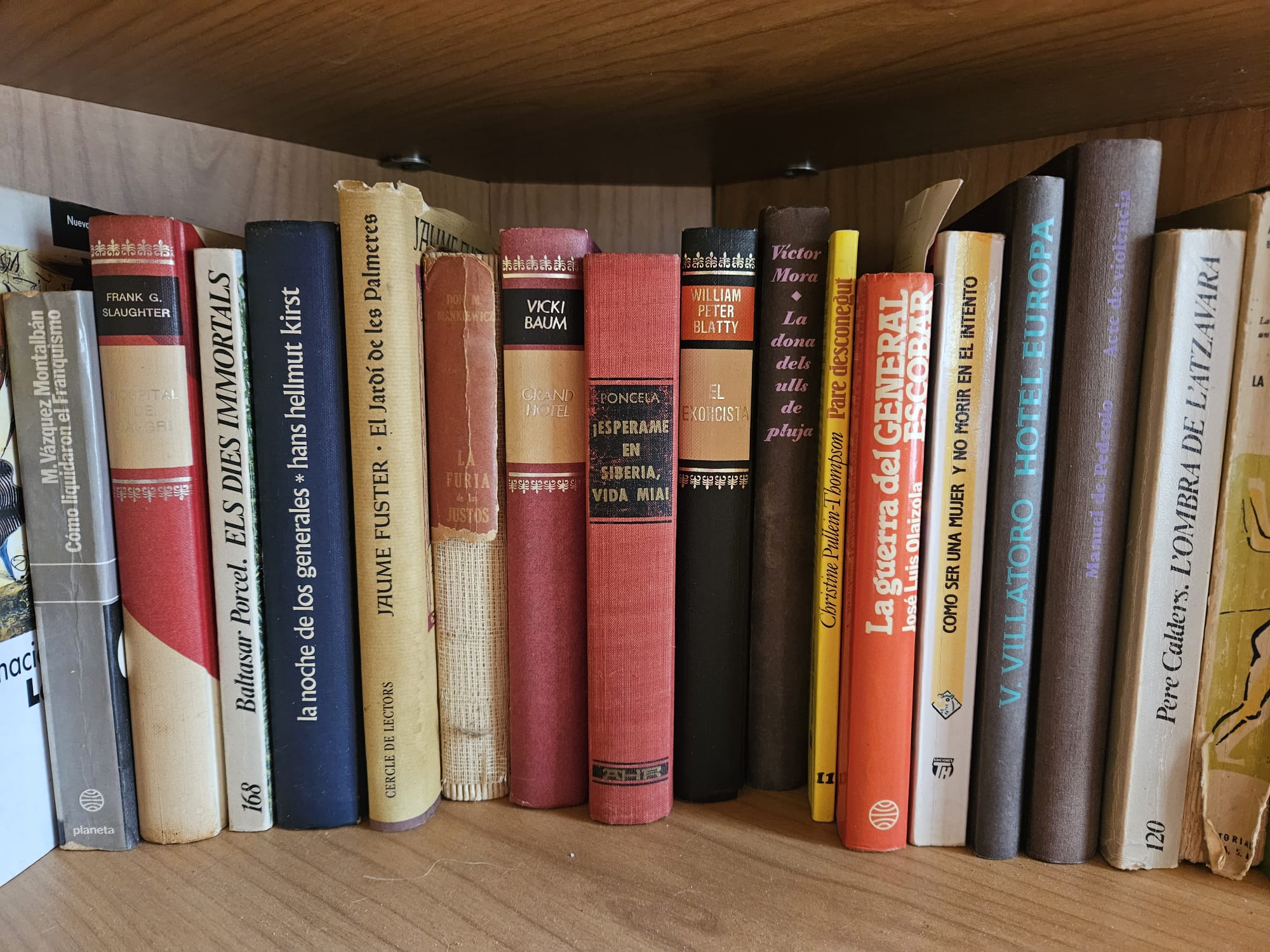
One book
“A Siberian Education”, by Nicolai Lilin.
I decided to read “A Siberian Education”, by Nicolai Lilin. It follows the lives of a group of “honest criminals” that live by their own rules in Transnitria. When visiting the region, our guide reminded us several times how the “criminal mafias” have shaped the recent history of the place.
The book gives a lot of insight on the life of Siberian people in Transnistria, in a clear, concise way:
In the Siberian community you learn to kill when you are every small
According to the criminal behavior, Siberian men cannot communicate with policemen
And you get a view on many aspects of it, from how they store and take care of guns (with crucifix on top), to their codes and the way they see life, family and fate. And how they fight!

Summary: In a contested, lawless region between Moldova and Ukraine known as Transnistria, a tightly knit group of “honest criminals” live according to strict codes of ritualized respect and fierce loyalty. In a voice utterly compelling and unforgettable, Nicolai Lilin, born and raised within this exotic subculture, tells the story of his moral education outside the bounds of “society” as we know it, where men uphold values with passion―and often by brute force.
